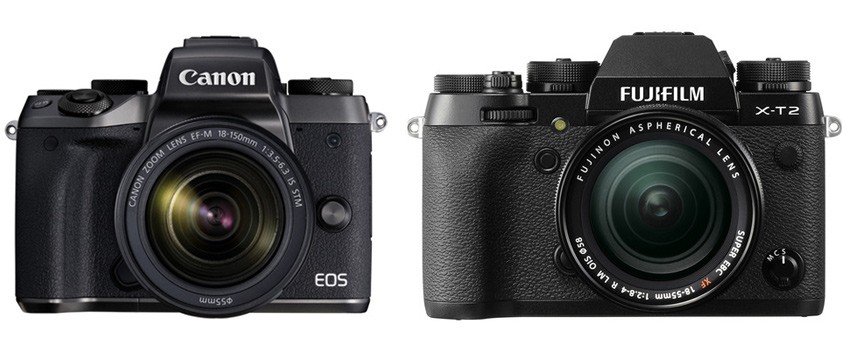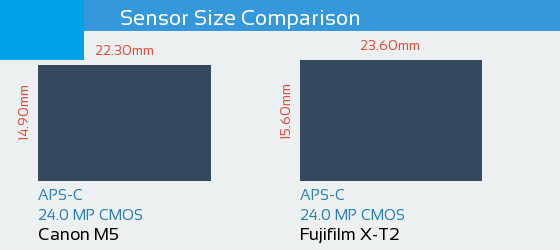Canon M5 vs Fujifilm X-T2
: Two mirrorless cameras up for comparison. This article compares Canon’s Semi-Pro Mirrorless camera, the Canon EOS M5, with Fujifilm’s mirrorless camera, the Fujifilm X-T2. Both cameras feature a 24.0MP APS-C sensor. To start, here’s a brief overview of the main features of both cameras.
Canon M5 vs Fujifilm X-T2 Specs

Canon M5 vs Fujifilm X-T2 – Comparison
Specifications |
Canon M5 |
Fujifilm X-T2 |
|---|---|---|
| Megapixels | 24.2 | 24.3 |
| Sensor Type | CMOS | CMOS |
| Sensor Format | APS-C | APS-C |
| Crop Factor | 1.6x | 1.5x |
| AA Filter | Yes | None |
| Image Resolution | 6000 x 4000 | 6000 x 4000 |
| Body Image Stabilization | Yes (Movie only) | No |
| Lens Mount | Canon EF-M | Fujifilm X |
| ISO | 100 – 25,600 | 200 – 12,800 |
| Expanded ISO | None | 100 – 51,200 |
| AF Points | 49 Hybrid | 325 AF Hybrid |
| Cross-type AF Points | Dual Pixel AF | 169 phase |
| Continuous Mode | 7fps | 8fps* |
| LCD | 3.2″ – Articulating | 3.0″ – Articulating |
| LCD Resolution | 1,620,000 dots | 1,040,000 dots |
| Touchscreen | Yes | No |
| Focus Peaking | Yes | Yes |
| Top LCD Display | No | No |
| Viewfinder Type | EVF (2.36M) | EVF (2.36M) |
| Viewfinder Coverage | 100% | 100% |
| Viewfinder Magnification | 0.77x | |
| Video Resolution | 1920×1080 (60/50/30/25/24p | 3840×2160 (30/25/24p) |
| 1280×720 (60/50p) | 1920×1080 (60/50p) | |
| Microphone Jack | Yes | Yes |
| Headphone Jack | No | No |
| Memory Card Type | SD | SD + SD |
| Dual Card Slots | No | Yes |
| SD UHS Support | UHS-I | UHS-II |
| Fastest Shutter Speed | 1/4000 | 1/32000 |
| Slowest Shutter Speed | 30″ | 30″ |
| Bulb Mode | Yes | Yes |
| JPEG Buffer Size | 27 | 55 |
| RAW Buffer Size | 18 | 48 |
| Time Lapse | Yes | Yes |
| Built-in Flash | Yes | No |
| Max Flash Sync Speed | 1/200 | 1/250 |
| Startup Time | 1.2s | 1.0s |
| Built-in Wi-Fi | Yes | Yes |
| Built-in GPS | No | No |
| Built-in NFC | Yes | No |
| Bluetooth | Yes | No |
| USB Type | USB 2.0 | USB 3.0 |
| Environmentally Sealed | No | Yes |
| Battery Life (CIPA) | 295 shots | 340 shots |
| Battery Included | Yes (LP-E17) | Yes (NP-W126S) |
| Weight | 15.0 oz (427g) | 17.9 oz (507g) |
| Size | 4.6 x 3.5 x 2.4″ | 5.2 x 3.6 x 1.9″ |
| Price | Amazon | Amazon |
| Release Date | 2016 | 2016 |
Fujifilm X-T2 vs Canon M5 Common Features
| Wireless Connection | Yes vs Yes | Better connectivity |
| Articulating Screen | Yes vs Yes | Flexible shooting positions |
| External Flash Shoe | Yes vs Yes | Better for flash photography |
| Viewfinder | Yes (Electronic) vs Yes (Electronic) | Better framing and control |
| RAW Support | Yes vs Yes | Better image quality |
| Face Detection Focus | Yes vs Yes | very handy for portraits |
| Max Resolution | 24 MP vs 24 MP | Bigger prints and more details |
| Microphone Port | Yes vs Yes | High-quality audio recording option |
| Timelapse Recording | Yes vs Yes | creative shooting |
| AE Bracketing | Yes vs Yes | Useful for tough lighting conditions and HDR |
| Smartphone Remote Control | Yes vs Yes | Remote control your camera with a smartphone |
Canon M5 vs Fujifilm X-T2 Size Comparison
The Canon M5 is 17mm narrower and 3mm shorter than Fujifilm X-T2, however, it is also 12mm thicker. Also, the Canon M5 is noticeably lighter than the Fujifilm X-T2. It weighs 80g less. The weight plays a huge factor when buying a digital camera. You don’t want to be carrying around a heavy camera for long periods of time.

Canon M5 vs Fujifilm X-T2 – Comparison
On the bright side, since both the Canon M5 and the Fujifilm X-T2 have an APS-C sized sensor the lenses for a similar focal length and aperture are generally the same weight.
Canon M5 vs Fujifilm X-T2 Sensor Comparison
Also, with regard to the sensor, both the Canon M5 and the Fujifilm X-T2 have APS-C sized 24.0 MP resolution sensors. Hence, sensor size and resolution are not different between these two cameras. Additionally, the Fujifilm X-T2 has a 1.1x Larger sensor area than Canon M5. Larger sensors allow the photographer more control over the depth of field and blurry background compared to the smaller sensor when shot in same focal length and aperture.

Canon M5 vs Fujifilm X-T2 Sensor Comparison
Another key difference between these two sensors is that the Fujifilm’s sensor lacks an anti-alias (Low-Pass) filter. Removing the anti-alias filter increases the sharpness and level of detail but, at the same time, it increases the chance of watery overlays occurring in certain pictures.
Canon M5 Advantages Over Fujifilm X-T2
| Wireless Connection | Yes vs Yes | Better connectivity |
| Articulating Screen | Yes vs Yes | Flexible shooting positions |
| External Flash Shoe | Yes vs Yes | Better for flash photography |
| Viewfinder | Yes (Electronic) vs Yes (Electronic) | Better framing and control |
| RAW Support | Yes vs Yes | Better image quality |
| Face Detection Focus | Yes vs Yes | Useful for portraits |
| Max Resolution | 24 MP vs 24 MP | Bigger prints and more details |
| Microphone Port | Yes vs Yes | High-quality audio recording option |
| Timelapse Recording | Yes vs Yes | Creative shooting |
| AE Bracketing | Yes vs Yes | Useful for tough lighting conditions and HDR |
| Smartphone Remote Control | Yes vs Yes | Remote control your camera with a smartphone |
Reasons why you might choose the Canon M5:
- Body Image Stabilization – It has body image stabilization but it only works in video.
- LCD – 3.2″ vs 3.0″.
- LCD Resolution – Higher resolution.
- Touchscreen Support
- Built-in Flash
- Built-in NFC
- Bluetooth Support
- Weight – The Canon M5 weighs 80g less.
- Size – The Canon M5 is noticeably smaller.
Video: Canon M5 Hands-on Review
Canon’s latest mirrorless camera promises to be an 80D in a smaller package. With 1080p and a reasonable 24-megapixels, is it another flop or does the Dual Pixel Autofocus save the day? Watch as Kai takes you through the pros and cons.
Fujifilm X-T2 Advantages Over Canon M5
| Number of Focus Points | 325 vs 49 | 276 more focus points |
| Max Shutter Speed | 1/8000s vs 1/4000s | faster shutter speed |
| Continuous Shooting | 14.0fps vs 9.0fps | 5 fps faster |
| Battery Life | 340 shots vs 295 shots | 45 more frames with a single charge |
| Headphone Port | Yes vs No | better video control |
| Environmental Sealing | Yes vs No | shoot at tough conditions |
| Sensor Pixel Area | 15.34µm2 vs 13.84µm2 | 10% larger pixel area |
| Max Video Resolution | 3840 x 2160 vs 1920 x 1080 | Higher Resolution Video |
| AE Bracketing Range | ±5 EV vs ±3 EV | Wide Bracketing range is useful for HDR |
| Flash Sync Port | Yes vs No | Connect off-camera flash |
| Storage Slot | 2 vs 1 | Extra storage slot |
| Support for UHS Memory Cards | UHS-II vs none | Read/Write in Ultra High Speeds |
Reasons to choose the Fujifilm X-T2 over the Canon EOS M5:
- AA Filter – The Fujifilm X-T2 has no AA filter.
- ISO – 51,200 vs 25,600. Higher maximum ISO sensitivity.
- AF Points – 325 vs 49.
- Continuous mode – 8fps vs 7fps. It’s an advantage, but not something you will really notice that often.
- Video Resolution – 4K video available.
- Dual Card Slots – More room for extra photos, or simply for backup.
- UHS-II – Faster writing speeds than UHS-I, but you need a memory card that can handle such speeds.
- Faster Max Shutter Speed – 1/32000 vs 1/4000.
- JPEG Buffer Size – 55 vs 27. Useful for long bursts.
- RAW Buffer Size – 48 vs 18.
- Max Flash Sync Speed – 1/250 vs 1/200.
- USB 3.0 – Faster file transferring out the camera.
- Environmentally Sealed – The Fujifilm X-T2 is better suited for shooting outdoors in difficult terrain and bad weather conditions.
Video: Fujifilm X-T2 Hands-on Review
You Might Also Like
- Canon M5 vs Nikon D7200: A Complete Comparison
- Canon M5 vs Fujifilm X-T20: A Detailed Comparison
- Canon M5 vs Nikon D5600: A Complete Comparison
- Canon M5 vs Fujifilm X-Pro2: A Detailed Comparison
- Canon M5 vs Pentax KP: A Detailed Comparison
- Canon M5 vs Sony A6500: A Detailed Comparison
- Canon M5 vs Nikon D5500: A Complete Comparison
- Canon M5 vs Olympus E-M5 II: A Complete Comparison
- Canon M5 vs Canon M6: A Complete Comparison
- Canon M5 vs Nikon D3300: A Complete Comparison
- Canon M5 vs Nikon D7100: A Complete Comparison
- Canon M5 vs Olympus E-M10 II: A Detailed Comparison
- Nikon D7200 vs Sony A6300: A Complete Comparison
- Canon M5 vs Pentax 3-K II: A Detailed Comparison
- Canon M5 vs Nikon D3400: A Complete Comparison
- Nikon D750 vs Panasonic GH5: A Complete Comparison